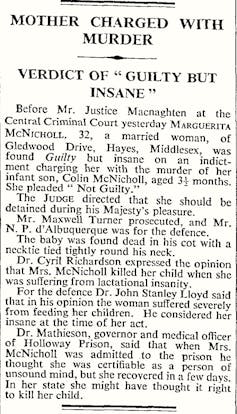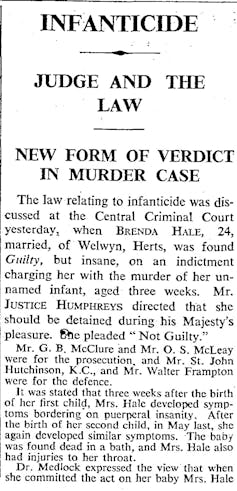
Paris Mayo gave birth to her son Stanley alone – at home, in silence, while her parents and brother were upstairs. Mayo claimed not to have known she was pregnant, and no one at her school or within her family had noticed her condition. She was 15 years old.
Within an hour of his birth, Stanley was dead. Mayo claimed he had “fallen out” of her as she laboured, hit his head and hadn’t moved. She then put his body in a bin bag and asked her brother to take it out with the rubbish.

Mayo’s mother found Stanley’s body the next morning and called the police, who launched a murder investigation. The postmortem found that Stanley had suffered a traumatic head injury, but that this had not killed him. Rather, he had died of suffocation after cotton wool was pushed down his throat.
Four years later in June 2023, Mayo stood trial at Worcester Crown Court, accused of murder. The prosecution claimed Stanley’s killing was premeditated – that Mayo had always known she was pregnant, concealed it and planned to kill the child at birth. Mayo’s defence counsel pointed to her youth – legally, she was not old enough to consent to sex when the baby was born – her difficult home life and lack of support, and her trauma at giving birth alone to a baby she had been in denial about. The judge, Mr Justice Graham, commented:
You went through the process of giving birth without the assistance of a midwife, a doctor, a friend or a relative. I find as a fact that you were frightened and traumatised by those events.
He made it clear to the jury that they could find her guilty of murder or the lesser charge of infanticide – an offence dating back to 1938 that occurs when:
A woman by any wilful act or omission causes the death of her child under the age of 12 months, but [whose] mind was disturbed by reason of her not having fully recovered from the effect of giving birth or by reason of the effect of lactation consequent upon the birth of the child.
The jury rejected this possibility, however, and found Mayo guilty of murder by a verdict of ten to two. She was sentenced to at least 12 years’ imprisonment. The judge acknowledged the hostile reaction she would receive in the press and on social media, in detention and when she was released, telling Mayo: “This will be a life sentence to you in every sense.”
For some, the death of a helpless baby in such violent circumstances was indeed an unforgivable and heinous crime. But to others, convicting a frightened, shocked teenager of murder and sentencing her to a long prison sentence was equally appalling. In a letter to the Guardian, Rod Morgan, the UK’s former chief inspector of probation, asked:
What on Earth are we doing when current penal policy suggests that this is an appropriate sentence for a child offender who killed her newborn child but who, in the judge’s words, was “vulnerable” and “ill-supported at home”? What purpose does such a lengthy minimum sentence serve?
Having spent much of my academic life examining different forms of child abuse, for the past two years I have focused on child abuse in English history, including cases of infanticide and other newborn child killings.
Mayo’s murder conviction surprised me, especially as it followed three other high-profile killings of infants by their mothers, who all received different verdicts and sentences. Such divergence demands investigation of how the UK legal system treats mothers who kill their babies. Was Mayo a cruel, calculating and evil woman who was rightly convicted of murder? Or was she a vulnerable teenager, traumatised by an unwanted pregnancy and failed by the UK’s legal system?
The killing that led to the law of infanticide
In April 1921, Edith Roberts – an unmarried, 21-year-old factory worker from Hinckley in Leicestershire – was arrested on suspicion of suffocating her illegitimate child. Roberts had concealed her pregnancy and gave birth without waking her sister, with whom she shared a bed. She wrapped the body in blankets and put it in a wooden chest, where her stepmother found it three days later.
When arrested, Roberts claimed the baby was stillborn. Evidence from the postmortem, however, showed her baby’s lungs had air in them and floated in water, indicating the child had drawn breath. Roberts’ defence relied on the claim that:
She was in a frenzy and agony of pain … and therefore hardly conscious of her own acts, and consequently not responsible.
While women had been allowed to sit on juries in criminal trials since 1919, in this case all the proposed female jurors were challenged, so Roberts was judged by an all-male jury who found her guilty of murder but recommended clemency. The judge, however, sentenced her to death, donning his black cap and telling the court it was his “painful duty” to pass “the only sentence the law allowed for the crime of which she had been convicted”. Roberts collapsed and was carried from the dock, crying hysterically.

The case caused an outcry: 30,000 people signed a petition demanding Roberts’ immediate release. There were calls for a change to the law to allow for clemency in cases where women had acted in a way that was morally abhorrent yet still understandable. Six days later, the home secretary commuted her sentence to life imprisonment – and after relentless campaigning by her local newspaper, the Leicester Mercury, Roberts was released the following year.
Around the same time, the 1922 Infanticide Act abolished the death penalty for women who had killed their newly-born child while “the balance of their mind was disturbed by childbirth”. While they could still receive a sentence equivalent to that awarded for manslaughter, this was rarely enforced. In the first year after the act was passed, of the 16 women convicted of infanticide in the UK, 12 were imprisoned but given relatively short sentences of between two and four years.
The new law was designed to deal with a “typical” perpetrator of infanticide – a young, unmarried woman who gave birth in secret, often in denial she had ever been pregnant. Women whose cases fell outside these parameters continued to be charged with murder and face much harsher penalties.
Cases for further reform
Mary O’Donoghue was a young Irish girl who had come to work in domestic service in England. After being hospitalised for 11 days following the difficult birth of her illegitimate child on August 19 1927, she found a job in a small hotel – only for her landlady to renege on her promise to look after the baby. O’Donoghue had apparently also developed an abscess in her breast, so was unable to breastfeed.
Lacking both money and food, on September 21 she tied a napkin around the baby’s neck and strangled [the child], then put the body in a box under her bed. Following its discovery, O’Donoghue was tried for murder – although her lawyer argued the charge should be infanticide. The court disagreed, arguing that O’Donoghue had been in sound mind and that her child was more than “one calendar month” old when she committed the act. She was found guilty and condemned to death, although this was soon commuted to penal servitude for life.

This article is part of Conversation Insights
The Insights team generates long-form journalism derived from interdisciplinary research. The team is working with academics from different backgrounds who have been engaged in projects aimed at tackling societal and scientific challenges.
In May 1935, 24-year-old Brenda Hale slit the throat of her three-week-old baby before trying to cut her own. She was remanded in Holloway prison, where she reportedly showed clear signs of mental confusion and could remember nothing about what had happened. In July the following year, she was tried for murder.
As a married woman who had neither denied nor concealed her pregnancy and had killed her second child, Hale was not a “typical” perpetrator. The judge, Mr Justice Humphreys, was sympathetic but could not be sure that the child, at three weeks old, classified as “newborn”. Although doctors testified it could take four weeks or longer to recover from birth, Humphreys was bound by the precedent of the O’Donoghue case. He directed the jury to find Hale “guilty of the act charged”, but also “insane so as not to be responsible in law” at the time of the killing. She was detained in prison for an indefinite (and unknown) period.

Four months later, in November 1936, another married woman, 32-year-old Marguerita McNicholl, was tried for the murder of her 14-week-old old son, who had been found dead in his cot having been strangled by a necktie. McNicholl pleaded not guilty and her defence claimed she was suffering from “lactational insanity”, caused by the difficulty she had feeding her child. After this defence was supported by medical experts and accepted by the judge and jury, McNicholl was also declared “guilty but insane”. Like Hale, she was imprisoned for an indefinite (but probably quite short) time.
In response to the Hale case, Labour MP John Jagger brought a bill before parliament in 1936 which would allow a verdict of infanticide to be returned for as long as the balance of the mother’s mind was disturbed by childbirth or lactation. He proposed this could apply until the child was eight years old.
Jagger also argued for the definition of “mental disturbance” to be expanded to cover external factors such as “distress and despair arising from solicitude for the child and extreme poverty, or either of these”. In the House of Commons debate, he cited the case of an unnamed 18-year-old who had drowned her illegitimate child of 18 months after the father refused to support her. She too was found guilty of murder and sentenced to death, only to be reprieved 13 days later. She should, he argued, have been convicted only of infanticide.
Jagger’s bill attracted much support but never became law because of the political crisis prompted by the abdication of the king. In 1938, though, a new Infanticide Act was passed which referred to the killing of a child under the age of one, by its mother when suffering from the after-effects of birth or lactation.

In the first two years after the new act was passed, 15 women were tried for infanticide and 14 convicted. Of these, 12 were released immediately but conditionally, one was freed on the day of the trial, and the other was declared “feeble minded” and released.
This 1938 act remains intact today, despite several further attempts at reform. The only change over the past 85 years was a 2018 Court of Appeal ruling that the act could be used in cases where women have long-standing mental health issues that predate the birth, providing the birth has exacerbated them.
One oft-repeated objection to the act, thoroughly explored in Ann-Marie Kilday’s A History of Infanticide in Britain, is that it discriminates against men who have no similar defence if they kill their babies. There has also been unease about the way it links pregnancy and childbirth to mental illness, not least because this reinforces stereotypes of women’s “mental and biological weakness”, and pathologises birth and lactation in a way that few today would recognise. The idea of difficulties with lactation being enough to drive a woman to kill appears especially anachronistic.
More recently, the act has been criticised for failing to consider children’s rights including the right to life, as well as contemporary understanding of child abuse and child protection. Karen Wells, professor of International Development & Childhood Studies at Birkbeck, University of London, has argued that much of the literature on infanticide focuses on the mother’s emotional turmoil and distress, while ignoring the abuse suffered by a vulnerable and defenceless child:
Looking at the literature on infanticide through the lens of childhood studies, it is striking how easily children’s rights to life are erased in favour of the rights of adults to self-determination.
Modern uses of the infanticide law
In July 2022, 25-year-old Lauren Saint George was tried at the Old Bailey for the murder of her ten-week-old daughter Lily-Mai, who had been born nine weeks premature. At the time, hospital staff raised serious concern with social workers about Saint George’s apparent lack of interest in Lily-Mai’s care.
Despite this, the baby was sent home with her mother on January 22 2018, only to die nine days later having sustained 18 rib fractures and a head injury. A postmortem revealed her leg had also been broken a few days before her death.
The jury found Saint George not guilty of murder, manslaughter and child cruelty – instead, she was convicted of infanticide and the judge, Mr Justice Martin Spencer, did not send her to prison. During the sentencing, he told Saint George:
It is quite clear to me you were depressed, still suffering from the effects of the birth at the time you committed the act that caused the death. The verdict of infanticide is one that has traditionally evoked sympathy rather than punishment.
Saint George was sentenced to two years’ imprisonment suspended for two years, along with a 12-month supervision order and 60-day rehabilitation requirement. After Saint George had said she planned to pursue further education, the judge told her: “You now have a future to look forward to.”
This case and verdict generated some unease given the death had occurred in the London borough of Haringey – location of several other catastrophic failures in child protection, including the killings of Victoria Climbié and Peter Connelly. Generally, however, newspaper responses were muted. The Mirror referred to Saint George as “a killer mum” and reported on her aunt’s disgust at what she perceived to be the leniency of the sentence, but the case triggered no lasting debate and no appeal was lodged in connection with the sentence.
Just under a year later, Sarah Jayne Barron, 34, was also convicted of infanticide after the body of her newborn baby was found in a garden in Weston-Super-Mare. After originally being charged with murder, the eventual charge put to Barron at Bristol Crown Court was that:
You caused the death of your child under 12 months by the wilful act of throwing them over the balcony of your flat, at a time when you had not fully recovered from the effects of giving birth.
Avon & Somerset police argued that “a charge of infanticide was the most proportionate outcome, taking all the circumstances into account”, and the Crown Prosecution Service concurred, calling it the “most appropriate charge” based on independent medical assessments. In July 2023, Barron received a three-year community order and again, the case drew little national media attention.
The killing of newly born children by their mothers remains rare in the UK. However, other recent cases appear to point to an increased willingness to charge women with murder or manslaughter, rather than this lesser and more nuanced crime of infanticide.
Harsher sentences for younger women
The seeming sympathy shown by the courts to Saint George and Barron was in marked contrast to the treatment of another young woman, Ellie Jacobs, who in April 2020 gave birth to a son, Archie, while living on a caravan site with her mother and her mother’s boyfriend. She was just 16.
The father of the baby had moved out shortly before the birth. Archie was put on a child protection plan by social workers but, as the UK had entered lockdown in March 2020, welfare checks were largely carried out by phone. Two weeks after Archie’s birth, Jacobs’ mother Sarah was killed in a high-speed car crash. Jacobs appeared to struggle to cope, writing in her diary:
I don’t know how much longer I can keep up this act of being OK. I don’t even know what it feels like to be OK anymore. I don’t think I will ever feel that again.

When Archie was five weeks old, Jacobs put a lethal dose of paracetamol in his bottle. After his death, he was found to have broken bones and Jacobs was charged with murder and child cruelty. An alternative charge of infanticide was not considered.
Before the start of her trial in June 2023, however, Jacobs admitted to the lesser charges of child cruelty and manslaughter, and was sentenced to five years’ imprisonment. In response, DCI Will Crowther of Thames Valley Police commented: “I am glad that during the trial, Ellie Jacobs finally accepted responsibility for her dreadful actions.”
It is difficult to believe that a jury 80 years ago would have found Mayo guilty of murder or Jacobs of manslaughter, or that they would have received such long sentences. Mayo, who was sentenced to at least 12 years’ imprisonment for the murder of her hour-old son, appeared to fit the “classic” pattern of the infanticidal mother very closely: a young unmarried mother in denial over her pregnancy, giving birth alone and in secret, trying to conceal the body and then claiming the baby was stillborn.
Jacobs too was very young and ill-equipped to care for a baby, even before her mother died. A pregnant 16-year-old living in a cluttered caravan with other family members surely suggests a certain level of psychological, social and economic stress – all exacerbated by the birth of her child, the death of her mother, and the isolation of the first COVID lockdown. Yet neither Jacobs nor Mayo benefited from the merciful intentions behind the 1938 Infanticide Act.
Is the act still fit for purpose?
When legislation on infanticide was introduced, it was driven by leniency, flexibility and sympathy. The act sought to protect a small number of highly vulnerable women whose mental health was seriously affected by the psychological and social circumstances surrounding their pregnancies. It recognised the fear, social marginalisation, mental health difficulties and vulnerability that unwanted, concealed or denied pregnancies can engender, enabling mercy to be shown to women in severe crisis.
More than a century on from the original act, and despite contemporary British society being supposedly more tolerant and sympathetic, Mayo and Jacobs were unable to provide compelling evidence of longstanding mental health issues – perhaps not surprising given they were so young – and also appear to have been overlooked by those who may have been in a position to provide such evidence.
Neither Mayo’s parents nor her school had noticed her pregnancy and she had not felt able to confide in anyone, nor ask for help. Mayo’s barrister described her as “a 15-year-old girl who was vulnerable, who was abused, who was not supported”.
Jacobs was clearly similarly vulnerable, yet in neither case were these teenagers – still children, according to the law – seen as suffering from mental health problems. Indeed, their youth and vulnerability, and their inability to ask for help, appears to have actively counted against them, hampering their pleas for leniency and mitigation.
In contrast, the jury at 25-year-old Saint George’s trial accepted, as did the police, Crown Prosecution Service and judge in 34-year-old Barron’s case, that both women had been suffering from post-natal depression and had killed their children while the balance of their minds were disturbed. Their crimes were punished, but mercy was shown in their verdicts of infanticide.
Punishing acts of unimaginable desperation
Throughout history, the killing of a newborn child by their mother has been a crime overwhelmingly committed by young, frightened, unmarried and socially marginalised women who felt they had no alternative, given the social stigma and economic hardship that raising an illegitimate child would entail. Many were in denial about their pregnancy and claimed their babies were stillborn.
Few of these women were brutal, and methods of infanticide have always relied heavily on asphyxiation, smothering, drowning or exposure. Historians have generally discussed infanticide as the desperate action of women who were not cruel or wicked, but who killed their children out of the need to try and protect themselves against social and economic ruin.
It has also long been recognised that pregnancy and childbirth can be so traumatic as to induce temporary madness. Puerperal insanity – now more commonly known as postpartum psychosis – has been a defence against child murder for many centuries. When this is compounded by secrecy and stigma, the effects are magnified.
Part of the problem today, however, may be that infanticide is no longer understandable in the way it was a century years ago. Pregnant women have options and abortion is (in the UK and many other countries) available and accessible – thereby positioning infanticide as an irrational, cruel and even evil choice when there are other ways of ending an unwanted pregnancy.
À lire aussi : The law of infanticide is supposed to provide merciful treatment for vulnerable mothers
Social changes, too, have been seismic. Giving birth outside marriage is no longer a social or economic disaster, and there is little stigma against single mothers, for whom welfare support is available.
At the same time, there is greater intolerance of child abuse – a crime now widely regarded as beyond understanding or clemency. The murder of a newborn baby or very young infant is seen as the ultimate act of abuse, for which there is little mitigation.
The jury in the Mayo case was given the option, by delivering a verdict of infanticide, of applying a law that, back in 1936, was hailed by the Times newspaper as “a welcome advance in humanitarian principles”. Such a verdict would have acknowledged the severity of Mayo’s crime while simultaneously conceding she was a desperate young woman who acted in crisis. The jury chose not to, and instead decided she was guilty of murder.
Sometimes, the changing attitudes and demands of society make a compelling argument for a change in legislation. In this case, however, I can see no strong argument for reframing or abolishing the existing Infanticide Act. Instead, what’s surely needed is greater support, protection and understanding for the young girls in particular who modern society seems increasingly inclined to punish for acts of sheer, unimaginable desperation. This historic act provides an important safety net for a handful of very vulnerable women – some of whom, it must be remembered, are still children themselves.

For you: more from our Insights series:
To hear about new Insights articles, join the hundreds of thousands of people who value The Conversation’s evidence-based news. Subscribe to our newsletter.
Heather Montgomery does not work for, consult, own shares in or receive funding from any company or organisation that would benefit from this article, and has disclosed no relevant affiliations beyond their academic appointment. Her book, Familiar Violence: A History of Child Abuse, will be published in February 2024 by Polity Press.
This article was originally published on The Conversation. Read the original article.







